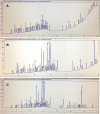In vitro pro-inflammatory enzyme inhibition and anti-oxidant potential of selected Sri Lankan medicinal plants
- PMID: 30285710
- PMCID: PMC6169004
- DOI: 10.1186/s12906-018-2335-1
In vitro pro-inflammatory enzyme inhibition and anti-oxidant potential of selected Sri Lankan medicinal plants
Abstract
Background: The extracts of the ten selected Sri Lankan medicinal plants have been traditionally used in the treatment of inflammatory mediated diseases. The extracts were investigated for anti-inflammatory and anti-oxidant potential in vitro to identify bio-active extracts for further chemical characterization.
Methods: In vitro anti-inflammatory activities of total ethanol extracts were investigated measuring the inhibitory activities of four pro-inflammatory enzymes, arachidonate-5- lipoxygenase (A5-LOX), hyaluronidase (HYL), xanthine oxidase (XO) and inducible nitric oxide (iNO) synthase. Cytotoxicity of extracts were determined by MTT assay. Oxidative burst inhibition (OBI) on human whole blood (WB) and isolated polymorphoneutrophils (PMNs) was carried out for a selected bio-active extract. Anti- oxidant activities of the extracts were determined by 2,2-diphenyl-1-picrylhydrazyl (DPPH) free radical scavenging, ferric reducing antioxidant power (FRAP), ferrous ion chelation (FIC) and oxygen radical absorbance capacity (ORAC) assays. Total polyphenol and total Flavonoid contents of the extracts were also determined. The most active plant extract was analysed using Gas chromatography-Mass spectrometry (GC-MS) and High Performance Liquid Chromatography (HPLC).
Results: The ethanol bark extract of Flacourtia indica showed the highest A5-LOX (IC50: 22.75 ± 1.94 g/mL), XO (70.46 ± 0.18%; 250 μg/mL) and iNOs inhibitory activities on LPS- activated raw 264.7 macrophage cells (38.07 ± 0.93%; 500 μg/mL) with promising OBI both on WB (IC50: 47.64 2.32 μg/mL) and PMNs (IC50: 5.02 0.38 μg/mL). The highest HYL inhibitory activity was showed by the leaf extracts of Barathranthus nodiflorus (42.31 ± 2.00%; 500 μg/mL) and Diospyros ebenum (41.60 ± 1.18%; 500 μg/mL). The bark and leaf extracts of Callophyllum innophyllum (IC50: 6.99 ± 0.02 μg/mL) and Symplocus cochinchinesis (IC50: 9.85 ± 0.28 μg/mL) showed promising DPPH free radical scavenging activities. The GC-MS analysis of ethanol bark extract of F. indica showed the presence of two major bio-active compounds linoleic acid ethyl ester and hexadecanoic acid, ethyl ester (> 2% peak area). The HPLC analysis showed the presence polyphenolic compounds.
Conclusion: The ethanol bark extract of F. indica can be identified as a potential candidate for the development of anti-inflammatory agents, which deserves further investigations. The bio-active plant extracts may be effectively used in the applications of cosmetic and health care industry.
Keywords: Anti-inflammatory; Anti-oxidant; Enzyme inhibition; F. indica; Gas chromatography-mass spectrometry; High performance liquid chromatography; Medicinal plants.
Conflict of interest statement
Ethics approval and consent to participate
Not applicable for this submission.
Competing interest
The authors declare that they have no competing interest.
Consent for publication
Not applicable for this submission.
Publisher’s Note
Springer Nature remains neutral with regard to jurisdictional claims in published maps and institutional affiliations.
Figures






Similar articles
-
Lipophilic extracts of Leucas zeylanica, a multi-purpose medicinal plant in the tropics, inhibit key enzymes involved in inflammation and gout.J Ethnopharmacol. 2018 Oct 5;224:474-481. doi: 10.1016/j.jep.2018.04.042. Epub 2018 May 1. J Ethnopharmacol. 2018. PMID: 29727733
-
Potential anti-inflammatory, antioxidant and antimicrobial activities of Sambucus australis.Pharm Biol. 2017 Dec;55(1):991-997. doi: 10.1080/13880209.2017.1285324. Pharm Biol. 2017. PMID: 28166708 Free PMC article.
-
Anti-inflammatory and Antioxidant Properties of Finger Millet (Eleusine coracana (L.) Gaertn.) Varieties Cultivated in Sri Lanka.Biomed Res Int. 2021 Oct 1;2021:7744961. doi: 10.1155/2021/7744961. eCollection 2021. Biomed Res Int. 2021. PMID: 34631888 Free PMC article.
-
Nutritional and medicinal plants as potential sources of enzyme inhibitors toward the bioactive functional foods: an updated review.Crit Rev Food Sci Nutr. 2024;64(27):9805-9828. doi: 10.1080/10408398.2023.2217264. Epub 2023 May 31. Crit Rev Food Sci Nutr. 2024. PMID: 37255100 Review.
-
Characterization of the xanthine oxidase inhibitory activity of alk(en)yl phenols and related compounds.Phytochemistry. 2018 Nov;155:100-106. doi: 10.1016/j.phytochem.2018.07.006. Epub 2018 Jul 23. Phytochemistry. 2018. PMID: 30096514 Review.
Cited by
-
The current status of old traditional medicine introduced from Persia to China.Front Pharmacol. 2022 Sep 14;13:953352. doi: 10.3389/fphar.2022.953352. eCollection 2022. Front Pharmacol. 2022. PMID: 36188609 Free PMC article. Review.
-
Eucalyptus torquata L. flowers: a comprehensive study reporting their metabolites profiling and anti-gouty arthritis potential.Sci Rep. 2023 Oct 31;13(1):18682. doi: 10.1038/s41598-023-45499-0. Sci Rep. 2023. PMID: 37907626 Free PMC article.
-
Iron chelating, antioxidant, and anti-inflammatory properties of brazilin from Caesalpinia sappan Linn.Heliyon. 2024 Sep 21;10(19):e38213. doi: 10.1016/j.heliyon.2024.e38213. eCollection 2024 Oct 15. Heliyon. 2024. PMID: 39397930 Free PMC article.
-
Coriander (Coriandrum sativum L.) essential oil and oil-loaded nano-formulations as an anti-aging potentiality via TGFβ/SMAD pathway.Sci Rep. 2022 Apr 21;12(1):6578. doi: 10.1038/s41598-022-10494-4. Sci Rep. 2022. PMID: 35449437 Free PMC article.
-
LC-ESI-MS/MS Polyphenolic Profile and In Vitro Study of Cosmetic Potential of Aerva lanata (L.) Juss. Herb Extracts.Molecules. 2022 Feb 13;27(4):1259. doi: 10.3390/molecules27041259. Molecules. 2022. PMID: 35209048 Free PMC article.
References
-
- Sen S, Chakraborty R, Sridhar C, Pradesh A. Free radicals, antioxidants, diseases and phytomedicines: current status and future prospect. Int J Pharm Sci Rev Res. 2010;03:091–100.
-
- Pala FS, Gürkan H. The role of free radicals in ethnopathogenesis of disease. Advances in Molecular Biology. 2008;1:1–9.
MeSH terms
Substances
Grants and funding
LinkOut - more resources
Full Text Sources
Medical
Miscellaneous

